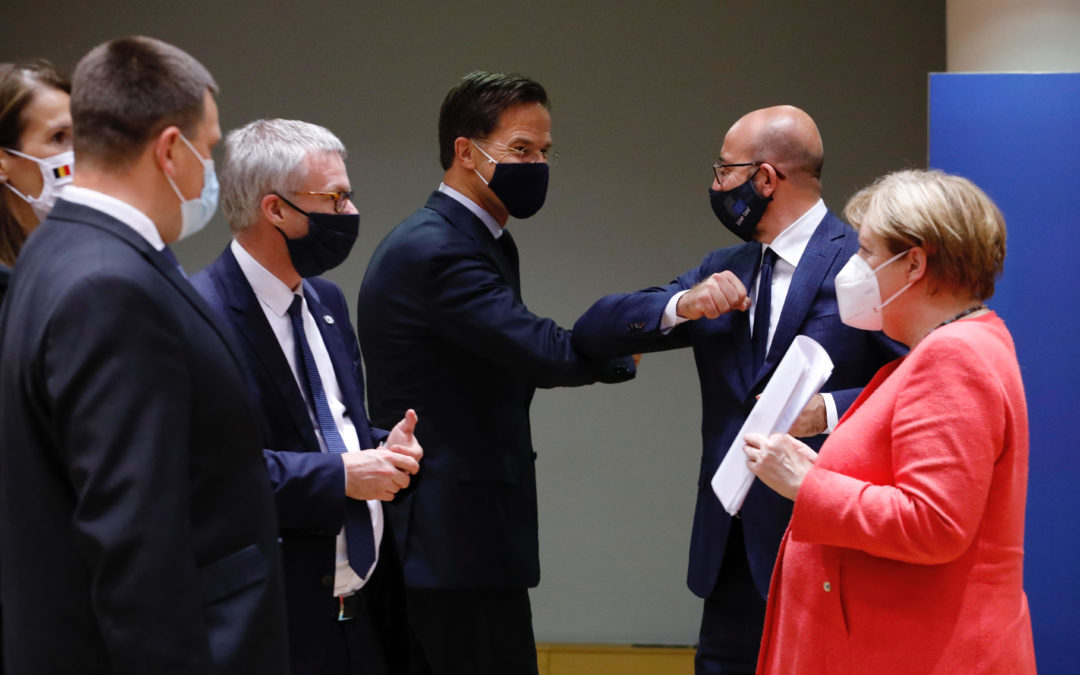The recovery fund agreed between EU leaders on 21 July is a big step forward for the European Union’s structure. Unfortunately, it is still an insufficient contribution to the post-pandemic European financial system and the path towards a low-carbon economy. More innovative monetary policies by the European Central Bank will still be needed to complement the EU’s recovery fund in the future.
On 21 July, European leaders agreed to create a €750 billion fund to help the European Union’s (EU) economy recover from the Covid-19 crisis. After four days and nights of intense and difficult negotiations in the European Council, the decision is the result of a compromise between heads of states and was praised as a historic milestone for Europe.
New powers for the European Commission
The decision is positive for three reasons.
Firstly, a key characteristic of the EU deal is that it will allow the European Commission to issue its own debt by borrowing on financial markets – something that was thought impossible until now due to the resistance of countries like Germany. In comparison, last year the Eurogroup had miserably and painfully agreed on a tiny €25 billion fund for stabilising the Eurozone – a figure dwarfed by the newly agreed recovery fund.
Secondly, the Commission will distribute this money to EU countries either in the form of grants (€390 billion) or cheap loans (€360 billion). The major advantage of this is that EU countries will benefit from more funding without having to increase their public debt. This should, therefore, help the weakest EU Member States to support their economies, although this is still open to debate.
Thirdly, the EU will agree later on on setting up ‘own-resources’ (i.e. EU-level taxes) that will be used to repay the debt. Although leaders have not agreed on this yet, they have mentioned several options such as a financial transaction tax, a carbon tax or a tax on multinational corporations. It is clear that the new debt will force EU leaders to find a compromise on this.
It is worth noting that the European Central Bank (ECB) will undoubtedly support the EU’s recovery package, not least by purchasing EU bonds on secondary markets through its ongoing quantitative easing programme – as is already the case with European Investment Bank bonds. By doing so, the ECB could significantly reduce the borrowing costs for the European Commission.
Too little and possibly too late
But there are many ways in which the deal falls short.
Firstly, as Positive Money Europe has warned since the beginning of this crisis, the recovery fund is not as big as it appears. In our opinion, the €360 billion of loans from the EU to member states are irrelevant, as they will only slightly lower the borrowing costs for some countries but not create additional stimulus (countries would have borrowed the money anyway on their own). Only the €390 billion of grants is actual additional stimulus, although at a macroeconomically insufficient volume for economies most affected by the crisis, such as Italy and Spain.
The timeliness of the spending is also key. To prevent a long-lasting recession, the money should be spent now rather than later. Under the agreed deal, the European Council wants to spend €200 billion between 2021 and 2022 – already a significant delay. This €100 billion per year is also significantly smaller than the EU budget (€148 billion in 2019) and represents only 0.7 percent of EU GDP. This is not an insignificant amount, but is insufficient given the massive scale of stimulus needed to avoid a cascade of bankruptcies for companies and citizens, let alone for funding the low-carbon transition.
Ultimately, given the difficulty convincing countries like the Netherlands to agree on this, it is possible that this deal effectively represents the limit on what Keynesian economists can hope for under the current status quo within the EU. In other words, after this agreement, we see little realistic prospect of the EU or the Eurozone to set up more ambitious central fiscal instruments to boost the recovery.
If Positive Money Europe’s fears are realised and the recovery plan is not enough to prevent a long-lasting recession and economic suffering for citizens, then other solutions will be needed.
The ECB is still the main player in town
Given its ability to create money, the ECB will once again be the main player. This puts other economic remedies to the Covid-19 pandemic on the table. Firstly, the ECB could deploy ‘helicopter money’ by distributing money directly to citizens in order to help people pay off their debts and stimulate an economic recovery through consumption. Secondly, the ECB could also theoretically write off the EU’s institutional and Member State debt that it owns as a result of its quantitative easing programmes, thus creating ‘fiscal space’ for governments to increase national investments.
In short, although Positive Money Europe welcomes the EU’s recovery fund plan as a big step forward for the EU’s fiscal capacity, we are aware of its limitations. This is why we will keep fighting to make sure the ECB does its part to complement the EU’s response through deploying innovative and effective monetary policy instruments.


I agree with you entirely, Europe or the world for that matter does not need to forever burden our selves with unsustainable debt. Helicopter money or writeing off the debt is the only sane solution.
Interestingly, I have also written an article on this very subject. I believe it will help inform your readers further on what is needed. If you permit me.
This is my take for the solution below.
Enough Is Enough!
Time for a reset (COVID 19 RESET)
It is now coming to a rapid conclusion that every government of the world needs to reset. In this instance we are talking about resetting the conditions of debt and money available to the world prior to Covid 19 virus making a devastating affect on the global economy.
The future presently looks bleak indeed. The virus is continually getting worse. Governments around the world are trying to protect businesses and save peoples livelihoods via job protection by making available money to cover the worst of the loss by supporting wages and business earnings. The government and thus all taxpayers everywhere are now indebted to incredible levels. This cannot be kept at this pace as it is unsustainable to continue in this way. Already money being made available from government to business and wages affected by this pandemic is already being reduced. We are now possibly facing a debt explosion that can cripple the world like nothing seen before.
Will this virus ever be defeated? It is probable that it will become another regular virus like the flu virus but more harmful and highly contagious in comparison to the normal flu, and like the flu it will mutate at a regular basis
So what can we do to avoid this ruination or decimation of our global economies?
A Reset is needed
In this instance we need to reset the conditions of debt and our money supply back to what it was before the covid 19 virus isolation measures took place. How can we accomplish this?
1/ All business earnings and wages lost due to the steps of controlling the pandemic will be reset to what it was before these measures were placed on the community. A national government loan would be put into action. It will borrow the full amount needed to reset these conditions, including the cost to the taxpayer for any payments already paid out to stricken businesses and wages loses.
2/Once the figure has been worked out, a government loan will be made to cover this. A reset will be initiated and this government loan will be extinguished by the printing off digital money.
3/ To ensure the economy continues to function, stimulus payments will be made to all businesses and to wages lost affected by virus implications on our economy. This money again will be borrowed initially and then extinguished by printing digital money to remove this debt.
How and Why
To understand how this can work, we need to understand the present way our money supply is created and engaged into the economy.
1/ Almost all new money is created and added into the community as debt.
2/ All debt must be paid back.
3/ All payments used to extinguish debt are removed from the economy. (decreases money supply)
The important thing here that we need to understand is that all money used to pay off debt is removed from the economy.
Once you understand this the solution is self evident.
There will be no inflation or deflation as we are only resetting conditions to what they where earlier. The money supply will be reset to what it was before covid 19 took place.
This process can continue until a level playing field has incurred. We need to maintain production for the needs of the population. It is vital that we maintain it. The answer is simple!
It is understandable that some people will be confused over the issue of printing money to remove this debt. Most people who will condemn this, say it will inflate the economy. It will massively depreciate the value of our currency and so on. It couldn’t be further from the truth!
If you increase the money supply to more than it needs you will get inflation. It is also true that by reducing the money supply to less than it needs you will get deflation. It is a matter of balance. In this instance we are doing neither, we are not increasing or decreasing the money supply. By printing money to pay off government debt we have turned debt into credit without changing the volume of money.
Conversely, paying off debt with money that was created in a debt based currency such as what we have now; you will actually be reducing the money supply of the nation. (See link below)
https://positivemoney.org/how-money-works/banking-101-video-course/how-money-gets-destroyed-banking-101-part-6/
If we simply added new money into the economy without keeping it in check with the supply of goods available, we will no doubt get inflation. This would be true regardless if it was printed off or created as debt. It’s the volume of money in circulation chasing the goods that counts. Money in reality should be only be created to represent real physical wealth or potential wealth, currently the opposite is true.
Regards,
Andrew Webb
That’s the proplem. The ECB could wipe off debt and they could use helicopter money to ease the problems that we are now facing from this epidemic. But they choose not to.
The money supply will shrink as a concequence as borrowing will decline. Banks will not lend in a risky environment.
As most of here on this forum know money must be continually created to maintain the money supply. It’s unfortunate that it must all be created as debt.
Our measures to control the epidemic is actually killing more people than it is saving.
This is more so in third world nations.
It is absulutly important that our supply of food and essential services are maintained. New money needs to be injected into our ecomies worldwide.
It is an absolute disgrace that the ECB are refusing to come aboard with these ideas. Millions more will die from hunger if nothing is done.
They will be responsible for this by their refusal to act responsibly to this situation.